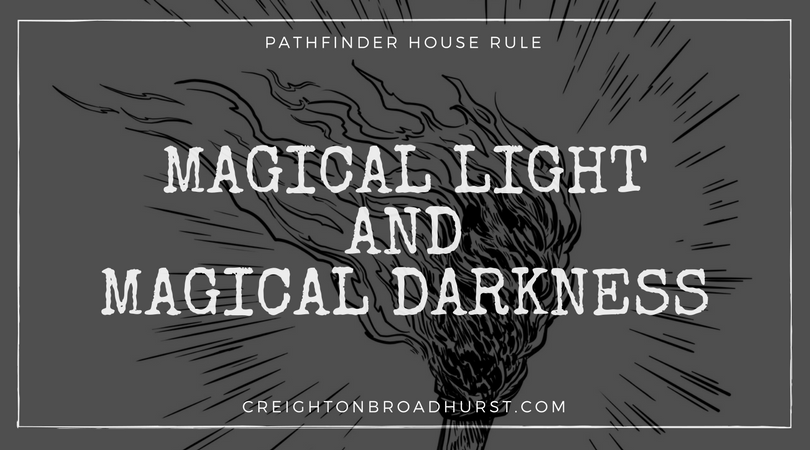Pathfinder’s rules for magical light and darkness are a bit of a tangled mess. I realised this the other day (in session #69 of my Shattered Star campaign) when a hydradaemon cast deeper darkness and the party’s cleric cast daylight in response.
The game screeched to a halt as we tried to work out how to handle this (and what happened to all the other magical and mundane light sources in the area). Later that night one of the group went online and found this “clarification” from Paizo about magical light and darkness. While—eventually—the clarification made sense to me, I can’t help thinking there must be a more elegant, simple solution to the situation. (Ideally one that doesn’t require a stimulating rules discussion and a tremendous amount of reading). After all, the plays the thing and anything that slows it down must be crushed.
Creighton’s Light and Darkness House Rules
So—without further ado—here are my quick and simple house rules for the interaction of magical light and darkness. I’ve boiled them down into the handful of bullet points below:
- Magical Light vs. Mundane Darkness: Magical light suppresses mundane darkness.
- Magical Darkness vs. Mundane Light: Magical darkness suppresses mundane light sources (such as a torch, lantern and so on).
- Magical Light vs. Magical Darkness: A spell with the light or darkness descriptor surpresses all lower-levels spells in its area of affect. Thus, when an object affected by a spell with the light descriptor enters the area of affect of a spell with the darkness descriptor (or vice versa) the spell with the highest spell level suppresses the other. Suppressed spells function as normal when removed from the more powerful area of affect. However, the time spent suppressed counts against the spell’s duration.
- Competing Area of Affects: The emanations of a lower level spell with the light descriptor cannot penetrate the area of affect of a higher level spell with the darkness descriptor. And vice versa.
- Counterspell: Spells with the light descriptor can be used to counter or dispel any spell with the darkness descriptor of equal or lower spell level. And vice versa.
What Do You Think?
I think the rules above are relatively simple and straightforward. They might not be the most realistic rules in the world, but they ensure play continues quickly and without interruption. What do you think? Let me know, in the comments below.


Is it your intention that a light spell is suppressed by a higher-level light spell, and the same with darkness spells? For example, Light would be suppressed by Daylight, and therefore would also last longer than if Daylight had not been cast.
Also, how does this rule apply to magic items which emit light, either as their primary function or as a cosmetic effect? Does it matter of they mimic a spell to do so, as opposed to merely shedding light?
Hi,
No, it’s not my intention that a light (or darkness) spell would be suppressed by a higher level spell. Which bit of the text gave you that impression?
Magic items which emit light (or darkness) would be dealt with as they spell they mimic. I think that’s the simplest thing, but I might add a note to that affect.
Thanks for the comments!
The only effect I might add somewhere (although it could be an effect too far) would be with competing areas of effect, and have a “penumbra and umbra” option – if the lower level spell is just one level lower, it reduces the light/darkness of the higher level spell by one step, e.g. causes a “penumbra” effect, whereas if the lower level spell is two or more levels lower, then it doesn’t affect the higher level spell at all, e.g. an “umbra” effect. However, I fully accept it’s just my mind that this makes sense to!
So basically the player rolls a dispel magic check? His versus the competing spell?
where did you get that from??
When a light or dark spell is cast to counter a standing spell, does the new spell persist, or do both effects cancel each other leaving no active spells? In other words, would have to cast your spell two times to see gain its effect?
Keep up the great content!